The Burrowers: Animals Underground Part 2 (Rabbits)
Last week in The Burrowers: Animals Underground Part 1 we saw an artificial rabbit warren built and populated with ten domestic rabbits, who quickly started work on increasing the head count. This weeks episode focuses on how life in the burrow prepares the babies for taking their first steps above ground.
Baby Rabbit Development
A month in, there are seven litters (over 20 kits) in the warren, but we follow Pipkins litter – possibility with a few cameos – I know they were going for the ‘wild look’ domestics, but as they are domestic anyway, it would have been handy to mix the colours so ID-ing individual rabbits was easier!
At two weeks old, the kits weigh five times the amount they did at birth, and start taking a few steps from the nest, but still inside their nest chamber. By 18 days old they are leaving the chamber and venture into adjoining tunnels where they encounter, and play with, other litters. By 3 weeks, they are ranging through whole warren, behaviour, we are told, is driven by the instinct to learn to navigate the tunnels – knowledge which will help protect them from predators. Again, it’s suggested the domestic offspring will behave the same as wild:
“Their parents are from domestic stock, but they should behave as they would in the wild, because our rabbit warren is based on data from the real thing.”
Although the babies mix freely, we are warned the adult females are very defensive of their nest chambers, and under stress territorial mums can kill kits that stumble into their path – it’s not clear if this ever became an issue during this study. At nearly 4 weeks old, and looking like mini rabbits instead of babies, we see them venture out for the first time into the pen above.
There isn’t much in the way of information here about life underground, but there were a lot of cute scenes of baby rabbits to ease the disappointment.
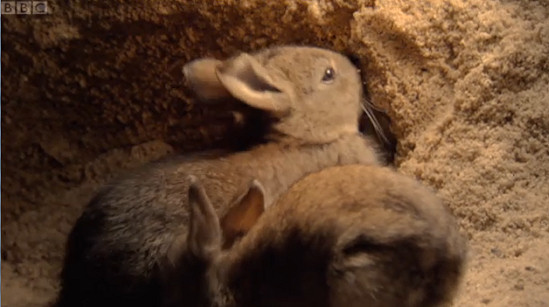
Aww, cute baby rabbits… science, who cares about science.
Water Voles & Grass
The program also covers water voles and badgers (and this week moles too), although they didn’t link it to rabbits, the section on grass and tooth growth in water voles was interesting. Like rabbits, apparently voles teeth grow continually to cope with the wear from the rough surface of grass – learn more on my blog post: Why grass is good for teeth.
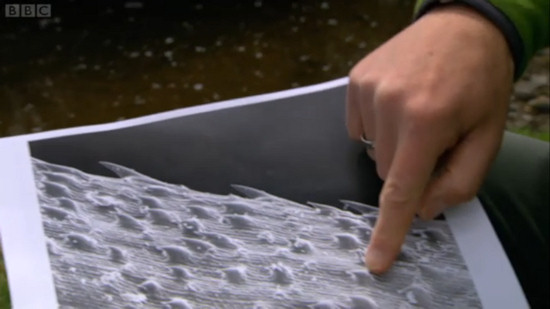
Close up of grass showing rough surface and ‘spikes’ of silica.
Excavating a Rabbit Warren
I found the section on excavating a warren the most fascinating. Back at the abandoned warren at Bicton park, they filled it with 10 tons of liquid concrete, and let it set. Then excavated it.
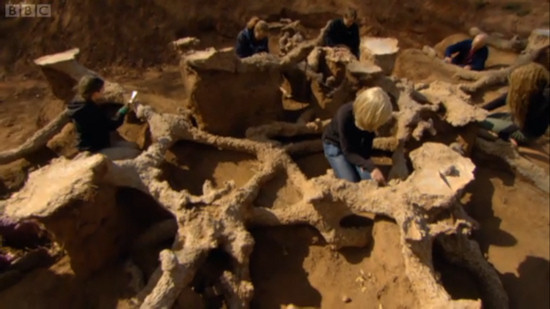
The excavation revealed multiple living chambers, with over 120m of tunnels, occupying same floor space as average new build home. At one junctions there are seven different tunnels meeting!
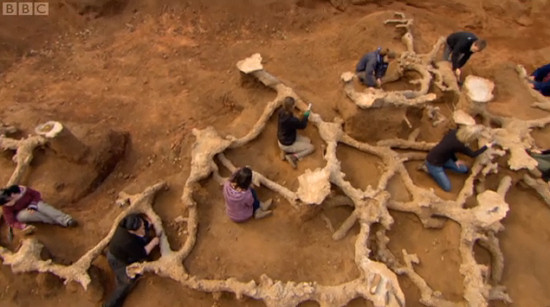
As you can see it’s a massive system of tunnels and living spaces. Now imagine the average four foot hutch super imposed, you can see why that’s woefully inadequate.
Predators
The big benefit of the warren system is protection them from predators, except the stoat. Which sometimes not only attacks but then take over the tunnel to nest in. Those watching just to enjoy cute bunny rabbits might want to skip a few minutes around 35minutes in. It’s not footage of the artificial warren’s rabbits, but it is grizzly. There are also a couple more predator shots at 46mins.
Back to the artificial warren, and they introduce the concept of physiological adaptions to help avoid predators – independently rotating ears, and eyes on side/top head so they can look up for buzzards and to the sides for ground predators. All in all rabbits are excellent at detecting whether there is a predator in the area, aren’t they? Not according to the TV crew: “We know there aren’t any predators in enclosure, but they don’t know that.” Lot of use those ears are then!
Which takes us back to the domestic/wild issue. Domestic rabbits act differently to wild rabbits, not necessarily because of their domestic genes but because they grow up in a safe environment. They learn from experience a weird smell/loud noise/giant human never indicates actual danger, so they start ignoring them. It’s how a skittish scardy rabbit can learn to relax and love nose rubs. Not that I particularly want to watch a warren complete with predators, I just don’t think rabbits ability to perceive whether or not there is any danger and the impact of removing danger on their behaviour should be ignored.
With the babies venturing outside for the first time, the mums behaviour is remarked on: “Look how attentive she is here, she’s head up the whole time, she’s not feeding at all, she’s looking around constantly vigilant, then occasionally she’s thumping away to warn them.”
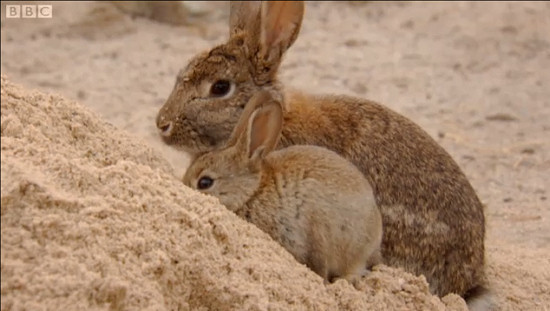
We still haven’t seen what the rabbits are feeding on. There is one shot of a baby nibbling on a remarkably intact looking gorse bush but the rest of the pen looks barren. Possibly she’s not grazing whilst supervising the youngsters because there is no grass?
One interest fact: The babies learn the right types of food to eat from the chemicals that were in the milk that they drank when in the warren – they know those plants won’t be poisonous because their mum ate them and survived. Which is a very logical explanation for how wild rabbits manage to avoid poisonous plants that our domestics would eat given half the chance.
There is a nice scene with a mixed group of adults and youngsters grooming each other, which the expert explains helps them build bonds and secure friendships so everyone can watch out for danger. Of course, the more rabbits working together, the more eyes/ears on lookup and the more time an individual can spend feeding (still wondering what they are feeding on).
Watch Episode 2 on BBC iPlayer Next week: how will rabbits cope with warren full to bursting?
Did you watch it? I’d love to know what you thought!
Tags: social-behaviour, wild-rabbit


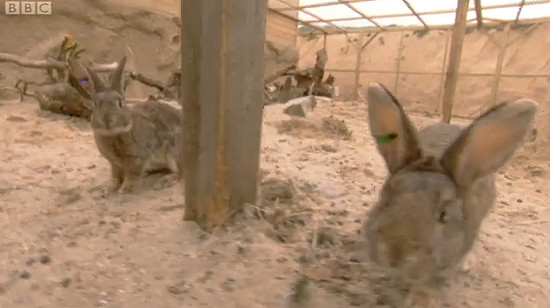
Hi tamsin! I watched both episodes so far and I love it! I’m only 13 but I really wish I could help wildlife more! By the way do you have a youtube channel? If you do I’ll subscribe!
Thanks, I do have a youtube channel here with a few videos: http://www.youtube.com/user/therabbithouse1